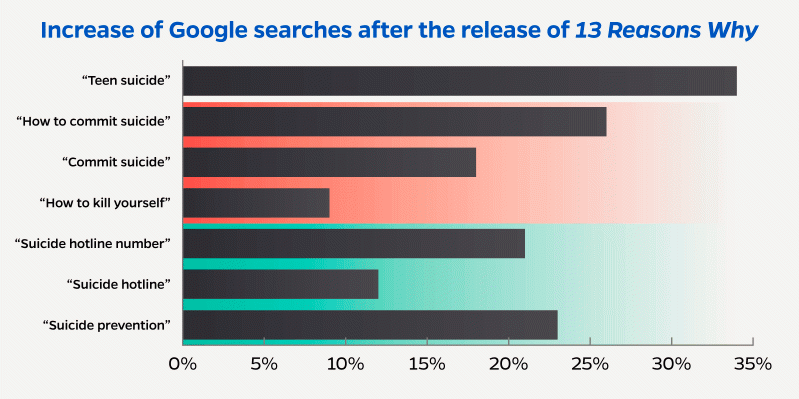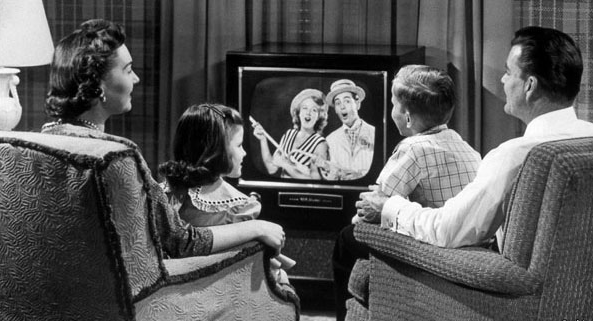The Effect of Entertainment Media on Perceptions of Mental Illness
(And how to be more mindful about it)
Earlier this year, the TV show “13 Reasons Why” was released on Netflix and has since generated heated debate over its depiction of mental illness. The show revolves around the suicide of Hannah Baker, a teenager in high school who undergoes a variety of distressing circumstances (thirteen to be exact), which contribute to her depression and eventual death.
A study in the Journal of American Medicine (https://tinyurl.com/yah2ndfn ) suggests that this TV show may have led to an increase in suicide rates by analyzing search rates from Google Trends before and after the show’s release. They write, “Our analyses suggest 13 Reasons Why, in its present form, has both increased suicidal awareness while unintentionally increasing suicidal ideation. The most rising queries focused on suicidal ideation. For instance, ‘how to commit suicide’, ‘commit suicide’ and ‘how to kill yourself’ were all significantly higher” (Ayers).
While some argue that the show contributes positively to public discourse by raising awareness about issues such as depression and suicide, others claim that it romanticizes Hannah’s death. Although the audience might be more aware of the issues presented in “13 Reasons Why,” they are not necessarily more informed, which is an important distinction.
The show is unapologetically graphic in its depiction of her suicide, which is extremely rare to see onscreen – for good reason. The American Foundation for Suicide Prevention has a list of recommendations for how to safely portray suicide in the media, and they explicitly indicate that, “Risk of additional suicides increases when the story explicitly describes the suicide method, uses dramatic/ graphic headlines or images, and repeated/extensive coverage sensationalizes or glamorizes a death.”
For more information about how the media can influence suicide rates as well as a list of warning signs and information about what to do if you notice someone exhibiting those signs, follow this link:
http://afsp.org/wp-content/uploads/2016/01/recommendations.pdf
Clearly the depiction of mental illness in films can have an enormous effect on how we perceive these issues. Sometimes, as in the above example, the effects can be extremely dangerous and serious. The media – specifically entertainment media – has been found to have the most powerful influence over an audiences’ attitudes toward mental illness than either news media, print media, or even real life experience (Otto).
Cultivation Theory:
One of the reasons why entertainment media (specifically pertaining to TV shows) can have such a powerful influence over an audience is due to an effect called Cultivation Theory. This theory states that the more people are exposed to a set of messages from television, the more these messages will influence their perceptions of the real world (Brodie 192).
This theory implies that entertainment media can be used in a very positive way, to spread accurate and helpful health information to a broad audience. “While viewers may not consciously watch fictional programs to learn about health information, cultivation theory suggests that health information presented in entertainment media could affect their ideas about health-related issues” (Brodie 192). Brodie et al.’s article outlines a study wherein the regular viewers of the TV show “ER” do indeed exhibit an increase in knowledge about various health issues due to their portrayal onscreen.
Unfortunately, entertainment media does not always portray mental health issues in the most positive light. According to Otto F. Wahl, “mental health advocates have asserted that the information provided by mass media tends to be unfavorable and inaccurate and that mass media depictions of mental illness play a significant role in perpetuating harmful misconceptions” (343). This is especially true of movies and television, in which mental illness is the most commonly depicted disability.
Inaccurate depictions of mentally ill people have perpetuated the stigma surrounding them. Wahl contends that, “Mentally ill persons presented in the mass media are typically social and occupational failures and possess a number of undesirable character traits, including a propensity for violence” (346). As a result, public opinion of those suffering from mental illness has grown more negative, as these characters are consistently being associated with negative traits.
Questions to ask yourself while watching entertainment media:
• Do any of the characters seem to be suffering from mental illness?
• How is this character (or characters) portrayed?
. . . . . . Are they a villain or antagonist?
. . . . . . Do they display violent tendencies?
. . . . . . Are they portrayed as a social or professional failure?
• Is any health information covered?
. . . . . . Is it true? If anything strikes you as suspect, exaggerated, or improbable, you can do your own research online to find out if it’s right.
• Does the movie or TV show follow the recommendations for safe mental health portrayal?
. . . . . . It can be difficult to remember all of the recommendations, but the main idea is to avoid sensationalizing or glamorizing real-life issues
Ayers, J. W., Althouse, B. M., Leas, E. C., Dredze, M., & Allem, J. (2017). Internet Searches for Suicide Following the Release of 13 Reasons Why. JAMA Internal Medicine, 177(10), 1527. doi:10.1001/jamainternmed.2017.3333
Brodie, M., Foehr, U., Rideout, V., Baer, N., Miller, C., Flournoy, R., & Altman, D. (2001). Communicating Health Information Through The Entertainment Media. Health Affairs, 20(1), 192-199. doi:10.1377/hlthaff.20.1.192
Otto, A. P., & Borsos, D. P. (2015). Analyze This: Ethical Behavior of Mental Health Clinicians As Portrayed in Film. PsycEXTRA Dataset. doi:10.1037/e642422012-001
Mass Media Images of Mental Illness: A Review of the Literature




Leave a comment
You must be logged in to post a comment.